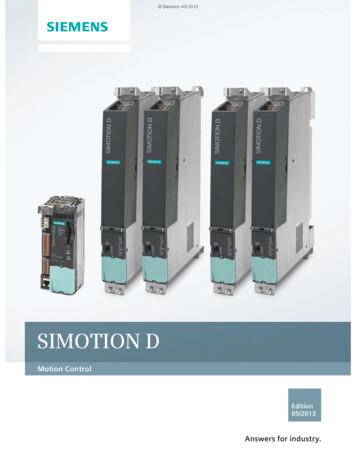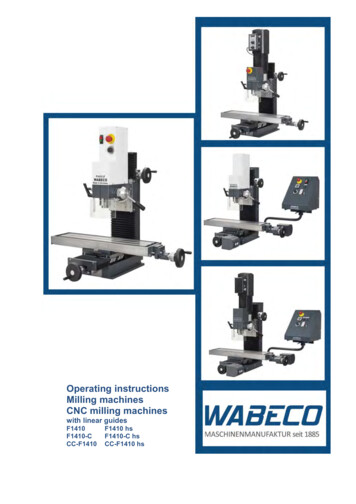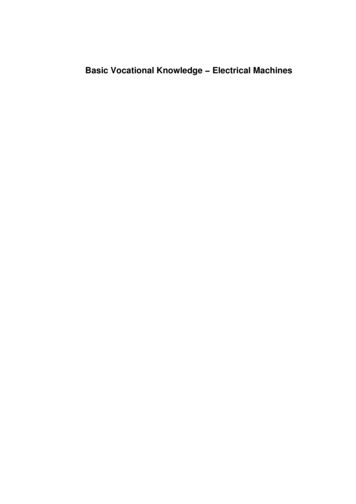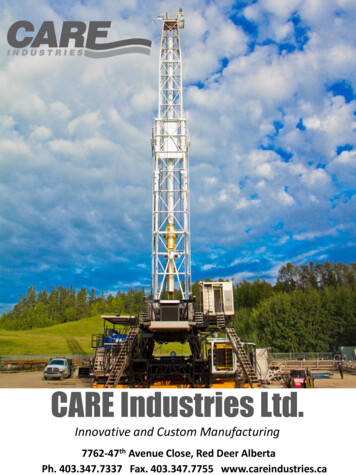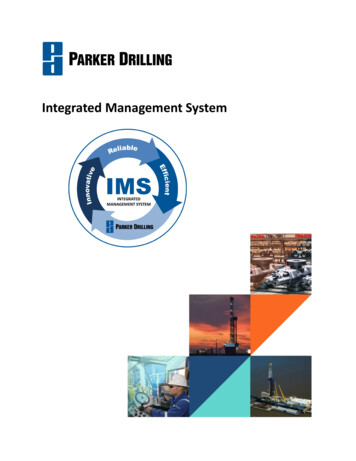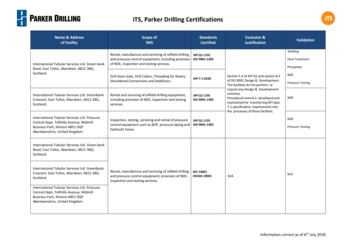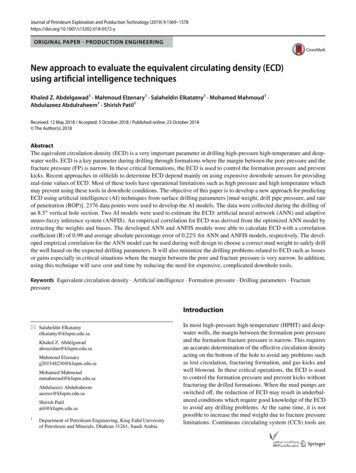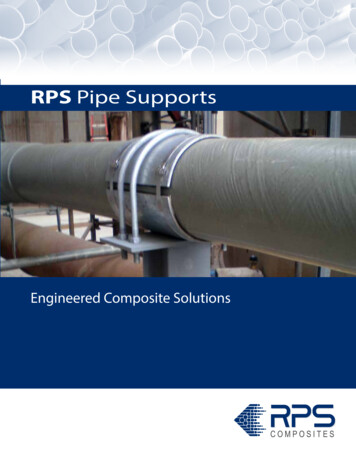
Transcription
TC 9-524Chapter 4DRILLING MACHINESGENERAL INFORMATIONPURPOSEUSESThis chapter contains basic information pertaining to drillingmachines. A drilling machine comes in many shapes andsizes, from small hand-held power drills to bench mountedand finally floor-mounted models. They can performoperations other than drilling, such as countersinking,counterboring, reaming, and tapping large or small holes.Because the drilling machines can perform all of theseoperations, this chapter will also cover the types of drill bits,took, and shop formulas for setting up each operation.A drilling machine, called a drill press, is used to cut holesinto or through metal, wood, or other materials (Figure 4-1).Drilling machines use a drilling tool that has cutting edges atits point. This cutting tool is held in the drill press by a chuckor Morse taper and is rotated and fed into the work at variablespeeds. Drilling machines may be used to perform otheroperations. They can perform countersinking, boring,counterboring, spot facing, reaming, and tapping (Figure 4-2).Drill press operators must know how to set up the work, setspeed and feed, and provide for coolant to get an acceptablefinished product. The size or capacity of the drilling machineis usually determined by the largest piece of stock that can becenter-drilled (Figure 4-3). For instance, a 15-inch drillingmachine can center-drill a 30-inch-diameter piece of stock.Other ways to determine the size of the drill press are by thelargest hole that can be drilled, the distance between thespindle and column, and the vertical distance between theworktable and spindle.Safety plays a critical part in any operation involvingpower equipment. This chapter will cover procedures forservicing, maintaining, and setting up the work, propermethods of selecting tools, and work holding devices to getthe job done safely without causing damage to the equipment,yourself, or someone nearby.4-1
TC 9-524the work. Feed pressure applied to the sleeve by hand orpower causes the revolving drill to cut its way into thework a few thousandths of an inch per revolution.The column of most drill presses is circular and builtrugged and solid. The column supports the head and thesleeve or quill assembly.The head of the drill press is composed of the sleeve,spindle, electric motor, and feed mechanism. The head isbolted to the column.The worktable is supported on an arm mounted to thecolumn. The worktable can be adjusted vertically toaccommodate different heights of work. or it may beswung completely out of the way. It may be tilted up to90 in either direction, to allow for long pieces to be endor angled drilled.The base of the drilling machine supports the entiremachine and when bolted to the floor, provides forvibration-free operation and best machining accuracy.The top of the base is similar to a worktable and maybeequipped with T-slots for mounting work too large forthe table.CARE OF DRILLING MACHINESLubricationCHARACTERISTICSAll drilling machines have the following constructioncharacteristics (Figure 4-4): a spindle. sleeve or quill.column, head, worktable, and base.The spindle holds the drill or cutting tools and revolvesin a fixed position in a sleeve. In most drilling machines,the spindle is vertical and the work is supported on ahorizontal table.The sleeve or quill assembly does not revolve but mayslide in its bearing in a direction parallel to its axis.When the sleeve carrying the spindle with a cutting toolis lowered, the cutting tool is fed into the work: and whenit is moved upward, the cutting tool is withdrawn from4-2Lubrication is important because of the heat and frictiongenerated by the moving parts. Follow the manufacturer’smanual for proper lubrication methods. Clean each machineafter use. Clean T-slots. grooves. and dirt from belts andpulleys. Remove chips to avoid damage to moving parts.Wipe all spindles and sleeves free of grit to avoid damagingthe precision fit. Put a light coat of oil on all unpaintedsurfaces to prevent rust. Operate all machines with care toavoid overworking the electric motor.Special CareOperations under adverse conditions require special care. Ifmachines are operated under extremely dusty conditions.operate at the slowest speeds to avoid rapid abrasive wear onthe moving parts and lubricate the machines more often.Under extreme cold conditions, start the machines at a slowspeed and allow the parts and lubricants to warm up beforeincreasing the speeds. Metal becomes very brittle in extremecold. so do not strike the machines with hard tools. Extremeheat may cause the motor to overheat. so use intermittent. oron and off, operations to keep the motor running cool.
TC 9-524TYPES OF DRILLING MACHINESThere are two types of drilling machines used bymaintenance personnel for repairing and fabricating neededparts: hand-feed or power-feed. Other types of drillingmachines, such as the radial drill press. numericallycontrolled drilling machine. multiple spindle drillingmachine, gang drilling machine, and turret drill press, are allvariations of the basic hand and power-feed drillingmachines. They are designed for high-speed production andindustrial shops.Drilling depth is controlled by a depth-stop mechanismlocated on the side of the spindle. The operator of themachine must use a sense of feel while feeding the cuttingtool into the work. The operator must pay attention and bealert. to when the drill breaks through the work, because ofthe tendency of the drill to grab or snag the workpiece,wrenching it free of its holding device. Due to the high speedof these machines, operations that require drilling speeds lessthan 450 revolutions per minute cannot be performed.Reaming, counterboring, and counter-sinking may requireslower speeds than drilling and may not be able to beperformed for all materials on these machines.Hand-FeedThe hand-feed drilling machines (Figure 4-5) are thesimplest and most common type of drilling machines in usetoday. These are light duty machines that are hand-fed by theoperator, using a feed handle. so that the operator is able to“feel” the action of the cutting tool as it cuts through theworkpiece. These drilling machines can be bench or floormounted. They are driven by an electric motor that turns adrive belt on a motor pulley that connects to the spindlepulley. Hand-feed machines are essentially high-speedmachines and are used on small workplaces that requireholes 1/2 inch or smaller. Normally, the head can be movedup and down on the column by loosening the locking bolts.which allows the drilling machine to drill different heights ofwork.4-3
TC 9-524Power-FeedThe power-feed drilling machines (Figure 4-6) are usuallylarger and heavier than the hand-feed. They are equipped withthe ability to feed the cutting tool into the work automatically,at a preset depth of cut per revolution of the spindle, usually inthousandths of an inch per revolution.These machines are used in maintenance shops for mediumduty work, or work that uses large drills that require powerfeeds. The power-feed capability is needed for drills or cuttingtook that are over 1/2 inch in diameter, because they requiremore force to cut than that which can be provided by usinghand pressure. The speeds available on power-feed machinescan vary from about 50 RPM to about 1,800 RPM. The slowerspeeds allow for special operations, such as counterboring,countersinking, and reaming.The sizes of these machines generally range from 17-inch toa 22-inch center-drilling capacity, and are usually floormounted. They can handle drills up to 2 inches in diameter,which mount into tapered Morse sockets. Larger workplacesare usually clamped directly to the table or base using T-boltsand clamps, while small workplaces are held in a vise. Adepth-stop mechanism is located on the head, near the spindle,to aid in drilling to a precise depth.SAFETY PRECAUTIONSGENERALDrilling machines have some special safety precautionsthat are in addition to those listed in Chapter 1.DRILLING MACHINE SAFETYDrilling machines are one of the most dangerous handoperated pieces of equipment in the shop area. Followingsafety procedures during drilling operations will helpeliminate accidents, loss of time, and materials. Listed beloware safety procedures common to most types of drillingmachines found in the machine shop.4-4Do not support the workplaces by hand. Use a holdingdevice to prevent the workpiece from being tom from theoperator’s hand.Never make any adjustments while the machine isoperating.Never clean away chips with your hand. Use a brush.Keep all loose clothing away from turning tools.Make sure that the cutting tools are running straightbefore starting the operation.
TC 9-524Never place tools or equipment on the drilling tables.Remove all chuck keys and wrenches before operating.Keep all guards in place while operating.Always wear eye protection while operating any drillingmachines.Ease up on the feed as the drill breaks through the workto avoid damaged tools or workplaces.TOOLS AND EQUIPMENTTWIST DRILLSTwist drills are the most common cutting tools used withdrilling machines. Twist drills are designed to make roundholes quickly and accurately in all materials. They are calledtwist drills mainly because of the helical flutes or grooves thatwind around the body from the point to the neck of the drilland appear to be twisted (Figure 4-7). Twist drills are simplyconstructed but designed very tough to withstand the hightorque of turning, the downward pressure on the drill, and thehigh heat generated by friction.Common twist drill sizes range from 0.0135 (wire gage sizeNo. 80) to 3.500 inches in diameter. Larger holes are cut byspecial drills that are not considered as twist drills. Thestandard sizes used in the United States are the wire gagenumbered drills, letter drills, fractional drills, and metric drills(See Table 4-1, in Appendix A). Twist drills can also beclassified by the diameter and length of the shank and by thelength of the fluted portion of the twist drill.Wire gage twist drills and letter twist drills are generallyused where other than standard fractional sizes are required,such as drilling holes for tapping. In this case, the drilled holeforms the minor diameter of the thread to be cut, and themajor diameter which is cut by tapping corresponds to thecommon fractional size of the screw. Wire gage twist drillsrange from the smallest to the largest size; from No 80(0.01 35 inch) to No 1 (0.2280 inch). The larger the number,the smaller the diameter of the drill. Letter size twist drillsrange from A (0.234 inch) to Z (0.413 inch). As the lettersprogress, the diameters become larger.Fractional drills range from 1/64 to 1 3/4 inches in l/64-inchunits; from 1/32 to 2 1/4 inches in 1/32-inch units, and from1/1 6 to 3 1/2 inches in 1/16-inch units.There are two common types of twist drills, high-speedsteel drills, and carbide-tipped drills. The most common typeused for field and maintenance shop work is the high-speedsteel twist drill because of its low cost. Carbide-tipped metaldrills are used in production work where the drill must remainsharp for extended periods, such as in a numerically controlleddrilling machine. Other types of drills available are: carbidetipped masonry drills, solid carbide drills, TiN coated drills,parabolic drills and split point drills. Twist drills are classifiedas straight shank or tapered shank (Figure 4-7). Straight shanktwist drills are usually l/2-inch or smaller and tit into geareddrill chucks, while tapered shank drills are usually for thelarger drills that need more strength which is provided by thetaper socket chucks.Metric twist drills are ranged in three ways: miniature set,straight shank, and taper shank. Miniature metric drill setsrange from 0.04 mm to 0.99 mm in units of 0.01 mm. Straightshank metric drills range from 0.05 mm to 20.0 mm in unitsfrom 0.02 mm to 0.05 mm depending on the size of the drill.Taper shank: drills range in size from 8 mm to 80 mm in unitsfrom 0.01 mm to 0.05 mm depending on the size of the drill.The drill gage (Figure 4-8) is used to check the diameter sizeof a twist drill. The gage consists of a plate having a series ofholes. These holes can be numbered, lettered, fractional, ormetric-sized twist drills. The cutting end of the drill is placedinto the hole to check the size. A micrometer can also be usedto check the size of a twist drill by measuring over themargins of the drill (Figure 4-9). The smaller sizes of drills arenot usually marked with the drill size or worn drills may havethe drill size rubbed off, thus a drill gage or micrometer mustbe used to check the size.4-5
TC 9-524It is important to know the parts of the twist drill for properidentification and sharpening (Figure 4-7).The heel is the conical shaped portion of the point in backof the cutting edge lips.The point is the entire conical shaped end of the drillcontaining the cutting edges and chisel edge.The body is the part of the drill that is fluted and relieved.The amount of slope given to the heel in back of the drilllips is called lip clearance. This clearance is necessary tokeep the heel from rubbing the bottom of the hole beingdrilled. Rubbing would prevent the drill from cutting.The shank is the part that fits into the holding device,whether it is a straight shank or a tapered shank.The flute is the helical groove on the drill. It carries outthe chips and admits coolant to the cutting edges.The chisel edge is the point at which the two lips meet. Thechisel edge acts as a chisel when the drill is turning and cutsinto the workpiece. The chisel edge must always be centeredexactly on the drill’s axis for accurate cutting action.The margin is the narrow surface along the flutes thatdetermines the size of the drill and keeps the drill aligned.The portion of the drill body that is relieved behind themargin is known as the body clearance. The diameter of thispart is less than that of the margin and provides clearance sothat all of the body does not rub against the side of the holeand cause friction. The body clearance also permits passageof lubricants around the drill.The narrowed end of the tapered shank drill is called thetang. The tang fits the slot in the innermost end of the drillspindle, drill chuck, or other drill holding device and aids indriving the tool. It also prevents the drill from slipping.The web of the drill is the metal section separating theflutes. It runs the length of the body between the flutes. Theweb gradually increases in thickness toward the shank,increasing the rigidity of the drill.The cutting edge lips cut like knives when fed and rotatedinto the workpiece. The lips are sharp edges formed bygrinding the flutes to a conical point.4-6An imaginary line through the center of the drill from endto end is the axis. The drill must rotate evenly about the axisat all times.
TC 9-524SPECIAL DRILLSSpecial drills are needed for some applications that a normalgeneral purpose drill cannot accomplish quickly or accurately.Special drills can be twist drill type, straight fluted type, orspecial fluted. Special drills can be known by the job that theyare designed for, such as aircraft length drills, which have anextended shank. Special drills are usually used in.high-speed industrial operations. Other types of special drillsare: left hand drill, Silver and Deming, spotting, slow spiral,fast spiral, half round, die, flat, and core drills. The generalpurpose high-speed drill, which is the common twist drill usedfor most field and maintenance shops, can be reground andadapted for most special drilling needs.SHARPENING TWIST DRILLSTwist drills become dull and must be resharpened. Thepreferred method of resharpening a twist drill is with the drillgrinding machine, but this machine is not always available infield and maintenance units, so the offhand method of drillsharpening must be used (Figure 4-10). The off hand methodrequires that the operator have a knowledge of the drillinggeometry (Figure 4-11) and how to change drill angles asneeded for any drilling job (see Table 4-2 in Appendix A).Tools needed are a utility or bench grinder with a dressedwheel and a drill point gage (Figure 4-12) or protractor headon the combination square. The drill point gage is set at 59 and adjusted along the steel rule to fit the drill to besharpened. The cutting lips must be of the same angle, the lipclearance angle must be within a specific degree range, andthe cutting lips must be of an equal length. There are severalbasic characteristics that all twist drills must have to cutproperly. The following will cover those characteristics.4-7
TC 9-524PRECHECKBefore sharpening a twist drill, the operator must check thecondition of the drill for chipped and cracked lips or edgesthat must be ground off during the sharpening process. Theoperator must also check the references for the proper lipangle and lip clearance angle for the material to be drilled.After setting up the bench grinder for offhand drillsharpening, the operator assumes a comfortable stance in frontof the grinding wheel to sharpen the twist drill. The suggestedmethod is to grind the lip angle first, then concentrate ongrinding the lip clearance angle, which will then determine thelip length. The usual lip angle is an included angle of 118 (59 x 2) (Figure 4-13), which is the lip angle of generalpurpose drills. Use the drill point gage frequently to check lipangle and lip length. When grinding, do not allow the drill tobecome overheated. Overheating will cause the drill edges tobecome blue which is an indication that the drill’s temper hasbeen lost. The blue area must be ground completely away toreestablish the drill’s temper. If a drill becomes too hot duringsharpening, the lips can crack when dipped into cold water orcoolant.When both the angles and the length of the angles areincorrect, then excessive wear is put on both the drill andmachine, which will result in poor workmanship (Figure 415).CLEARANCE ANGLEDRILL POINTWhen grinding the lip angle, use the drill point gage andgrind one lip perfectly straight and at the required angle(usually 590). Then flip the drill over and grind the other lip.Once the angle is established, then the lip clearance angle andlip length can be ground. If both lips are not straight and ofthe same angle, then the chisel edge (Figure 4-14) will not beestablished. It is it important to have a sharp and centered chiseledge or the drill will not rotate exactly on its center and thehole will be oversized. If the drill point is too flat, it will notcenter properly on the workpiece. If the drill point is too steep,the drill will require more power and cut slowly. When theangles of the cutting lips are different, then the drill will onlyhave one lip cutting as it revolves. The hole will be oversizedand the drill will wear very rapidly.4-8When grinding the lip clearance angle, (Figure 4-13), reliefmust be given to both cutting edges allowing them to enterinto the workpiece to do the cutting. General purpose drillshave a clearance of 8 to 12 . The chisel edge of a correctlyground drill should be at an angle of about 45 with the line ofthe cutting edges. The angle of the chisel edge to the lips is aguide to the clearance (Figure 4-16). Too much clearance willcause the drill to break down because of insufficient supportof the lip, and there will not be enough lip thickness to carryaway the generated heat.Too little clearance will result in the drill having little or nocutting edges, and the increased pressure required to feed itinto the hole will cause the drill to break. By looking straightonto the cutting tip of the drill, the operator can see if thechisel edge is correct. If the chisel edge is correct at 45 to the
TC 9-524lips, then it is an indication that the lip clearance angle iscorrect. An incorrect chisel edge is usually produced byholding the drill at an incorrect angle to the wheel (Figure 417) when grinding. A good guide is to hold the drill parallelto the ground, and make slight adjustments.ground from each flute. The web should not be ground toothin as this may weaken the web and cause the drill to split inthe middle.RAKE ANGLEThe angle between the flute and the axis of the drill thatforms the cutting edge is known as the rake angle (Figure 418). Generally, the rake angle is between 180 and 450, with30 being the most common. Drills used on armor plate orother very hard materials need a reduced rake angle toincrease the support behind the cutting edge. Soft materials,like brass and bronze, also use a reduced rake angle toprevent the drill from grabbing. The rake angle partiallygoverns the tightness with which the chips curl and theamount of space they occupy. If the rake angle is too small,the lips may be too thin and break under the strain ofdrilling. Too large of a rake angle makes the drill chatter andvibrate excessively.The web of a drill is made thicker toward the shank tostrengthen the tool. In smaller size drills, the difference is notnoticeable, but in larger drills, when the point is ground backby repeated sharpening, the thickness of the web becomesgreater and the chisel edge of the drill becomes wider. Thiscauses the chisel edge to scrape on the bottom of the hole andrequires excessive pressure to be applied to the drill. This canbe corrected by thinning the web (Figure 4-19). The point isground thinner on a thin grinding wheel with a rounded faceto fit into the flute. An equal amount of metal should beDRILL GRINDING MACHINESDrill grinding machines (Figure 4-20) make the accurategrinding of all types and sizes of drills an easy job.Comparatively little skill is required to sharpen drills withthese machines while following the operating instructions.4-9
TC 9-524They are particularly valuable when a large number of thesame general type of drills are to be sharpened. Two basicdesigns for the bench-type drill grinding machines areavailable. Both perform the same operations but use differentdrill holding devices. The capacity of these machines is statedin the horsepower of the electric motor and the sizes of drillswhich can be accommodated by the drill holding devices.SINGLE WHEEL FIXTUREOne kind of bench-type drill grinding machine consists of anelectric motor, a grinding abrasive wheel attached to the motorshaft, and fixtures to hold and position all types of twist drillsfor drill grinding. A web thinning drill grinding attachment,drill holder assembly, and swinging arm hold the drill in afixed position for each grinding operation and permit thecutting edge lips to be ground symmetrically at the correctangle and with the correct clearance to ensure long life andefficient cutting. Collets and bushings are supplied with thedrill grinding machine to hold a wide range of different sizeddrills. The grinding machine has a diamond set in the wheeldressing arm to dress the grinding wheel as necessary.DOUBLE WHEEL SWING ARMAnother kind of bench type drill grinding machine isequipped with two grinding abrasive wheels, one at each endof the motor shaft. One wheel is beveled for thinning the webof the drill at the point. The other wheel is used for lipgrinding. The grinder includes a wheel holder assembly formounting the drill and providing a means for bringing the drillinto contact with the grinding wheel at the correct angle andfeed to obtain proper clearance angles. A thinning drill pointrest is mounted forward of the beveled grinding abrasivewheel to rest and guide the drill during web thinningoperations. A wheel dresser is provided to dress the grindingwheel as necessary.OTHER TYPES OF CUTTERSDrilling machines use cutters, that are not drills, toproduce special holes. Below are listed the most commontypes.are cone shaped with angles of 82 . Cone angles of 60 ,90 ,100 ,110 , and 120 are for special needs.COUNTERSINKSCOUNTERBORESCountersinks (Figure 4-21) are special angled cutters used tocountersink holes for flathead screws so they are flush withthe surface when mounted. The most common countersinksCounterbores (Figure 4-21) are special cutters that use apilot to guide the cutting action to enlarge a portion of a hole.Common uses are for enlarging a hole to make a bolt head fitflush with the surface.4-10
TC 9-524COMBINED COUNTERSINK AND CENTERDRILLThis special drilling tool (Figure 4-21) is used to start holesaccurately. These tools are mainly used to center drill andcountersink the end of round stock in a lathe machine.REAMERSReamers (Figure 4-21) are cutting tools that are used toenlarge a drilled hole by a few thousandths of an inch for aprecise fit.BORING TOOLSBoring tools (Figure 4-21) are not usually considered withdrilling, but they can be used to bore a hole using the powerfeed drilling machines. These tools consist of an arbor with atool bit attached that cuts a preset sized hole according to thedistance that the tool bit protrudes from the arbor.FIELD EXPEDIENT CUTTERSUnder battlefield conditions, the exact tools may not beavailable for each job. Simple flat drills can be made quicklyfrom a high-speed steel lathe tool bit or a drill blank. If agrinder is available, then a crude drill can be ground that has apoint and two flat edges, which could produce a hole ifenough pressure is applied and the workpiece is machinable.TAP AND DIE WORKHand tapping and hand die work can be done on a drillingmachine. The drill chuck is used to align the tap or die.DRILL HOLDING DEVICESThe revolving vertical spindle of the drilling machine holdsand drives the cutting tool. In order to use various sizes andshapes of drills in various machines three types of drillholding devices, which fit the spindle of the drilling machines,are used: the geared drill chuck, the drill sleeve, and the drillsocket (Figure 4-22). The larger drilling machines have aspindle that has a standard Morse taper at the bottomend. There are three types of drill holding devices: the geareddrill chuck, the drill sleeve, and the drill socket.GEARED DRILL CHUCKSDrills with straight shanks are held in geared drill chuckswhich have three adjustable jaws to clamp onto the drill.Smaller size drills are made with straight shanks because ofthe extra cost of providing these sizes if tapered. Geared drillchucks come in various sizes, with the 3/8 or 1/2-inchcapacity chuck being the most common. The shank of thechuck is set into the spindle of the drilling machine byinserting the chuck’s shank into the spindle’s internal taperand seating the shank into the taper with a light blow with asoft hammer. Both the internal and external taper surfacesmust be clean and free of chips for the shank to seat and lockproperly. The drill is locked into the chuck by using thechuck key to simultaneously tighten the three chuck jaws.Geared drill chucks can also come with a morse taperedshank and may have a different method of attaching Theymay screw on, have a Jarno taper, or a Jacob’s back taper.DRILL SOCKETS AND DRILL SLEEVESMorse taper shank drills come in several sizes, thus, adaptersmust be used for mounting them into various drilling machinespindles. Drill sleeves and drill sockets are designed to add toor subtract from the Morse taper for fitting a drill into thechuck spindle. For example, it is common for a 3/4 inch twist4-11
TC 9-524drill to have a Morse taper of size #2, #3, or #4. It is also common for a drilling machine spindle to have a Morse taper ofsize #3 or #4, and it can be adapted for many other Morsetaper sizes, depending on the size of the drill.A drill too small for the machine spindle may be fitted into asocket or sleeve which has a taper hole of the proper size tohold the drill and a taper shank of the proper size to fit thedrill spindle. Sometimes, more than one socket or sleeve isneeded to build up the shank to tit into the drilling machinespindle. Sockets and sleeves may be obtained in a number ofdifferent sizes and hole shank taper combinations. Sockets,sleeves, and taper shank drills are mounted into the aligningslots of the spindle and lightly tapped with a sotf hammer toseat in place.DRILL DRIFTSDrill drifts are flat, tapered keys with one rounded edge thatare designed to fit into a spindle chuck’s slot to force a taperedshank drill loose. The rounded top of the small end of the drilldrift is designed to face upward while inserting the drift intothe slot. There are two types of drill drifts, the standard typeand the safety type (Figure 4-23). The standard drift must beinserted into the chuck’s slot and then struck with a softhammer to jar the taper shank drill loose. The drill will fallquickly if not held by the hand and could break or causeinjury. The safety drill drift has a sliding hammer weight onthe drift itself to allow for a free hand to stay constantly on thedrill as it comes loose.WORK HOLDING AND DRILLINGDEVICESWork holding devices are used to hold the work steady foran accurate hole to be drilled, and so a safe drilling operationcan be accomplished. Drilling support devices are used tokeep the workpiece above the worktable or vise surface and tokeep the workpiece aligned for drilling. Some devices arefairly simple and are used for drilling operations that do notrequire a perfect hole. Other devices are very intricate anddesigned for more accurate drilling. Many work holdingdevices are used with one another to produce the most stablework setup for drilling.MACHINE TABLE VISESA machine table vise is equipped with jaws which clampagainst the workpiece, holding it secure. The vise can bebolted to the drilling table or the tail can be swung around tolay against the column to hold itself steady. Below are listedmany types of special purpose machine table vises available tomachine operators.4-12
TC 9-524The standard machine table vise is the simplest of allvises. It is equipped with two precision ground jaws forholding onto the work and a lead screw to tighten the onemovable jaw to the work (Figure 4-24).The swivel
DRILLING MACHINE SAFETY Never make any adjustments while the machine is operating. Drilling machines are one of the most dangerous hand operated pieces of equipment in the shop area. FollowingNever clean away chips with your hand. Use a brush. safety procedures during drilling operations wi
